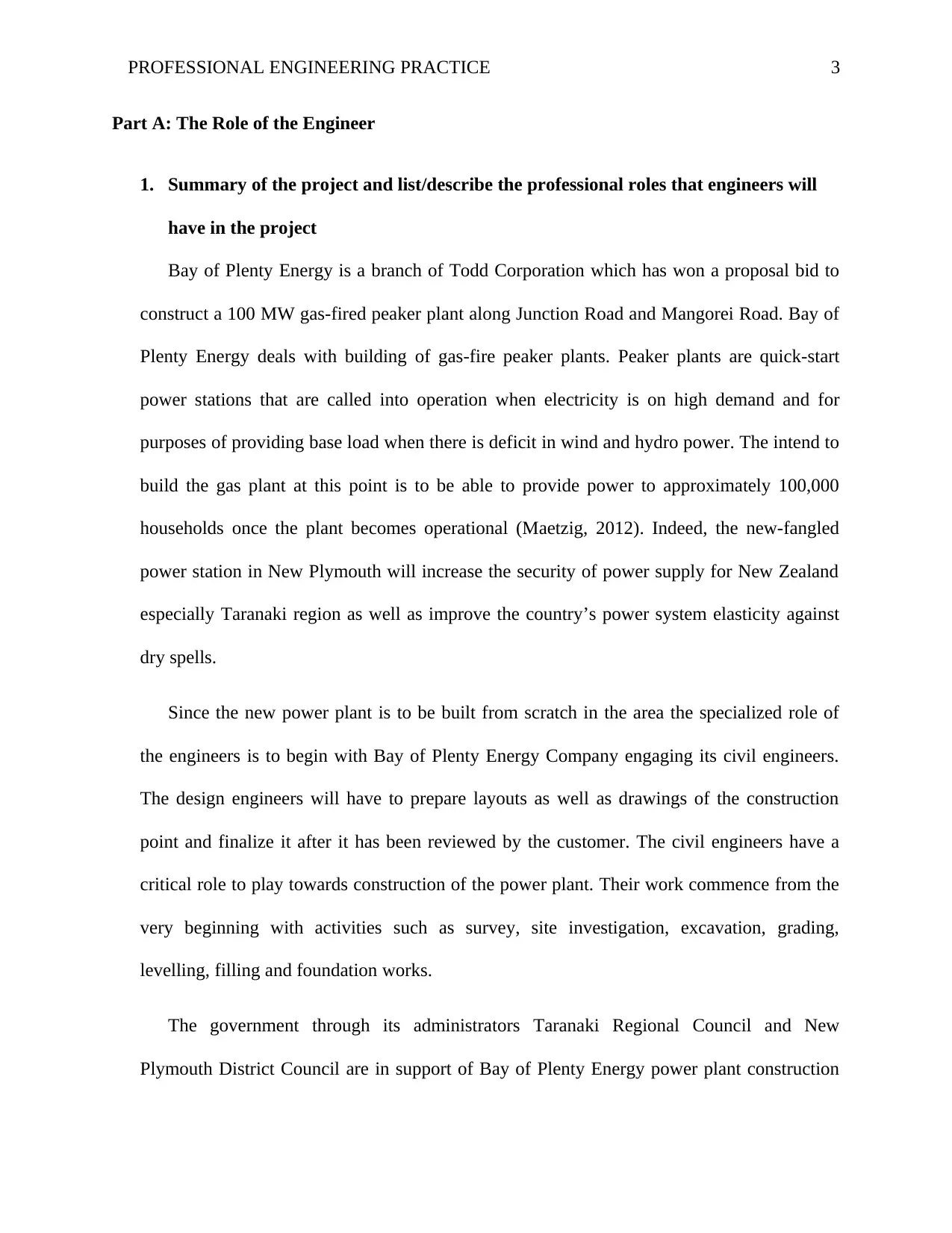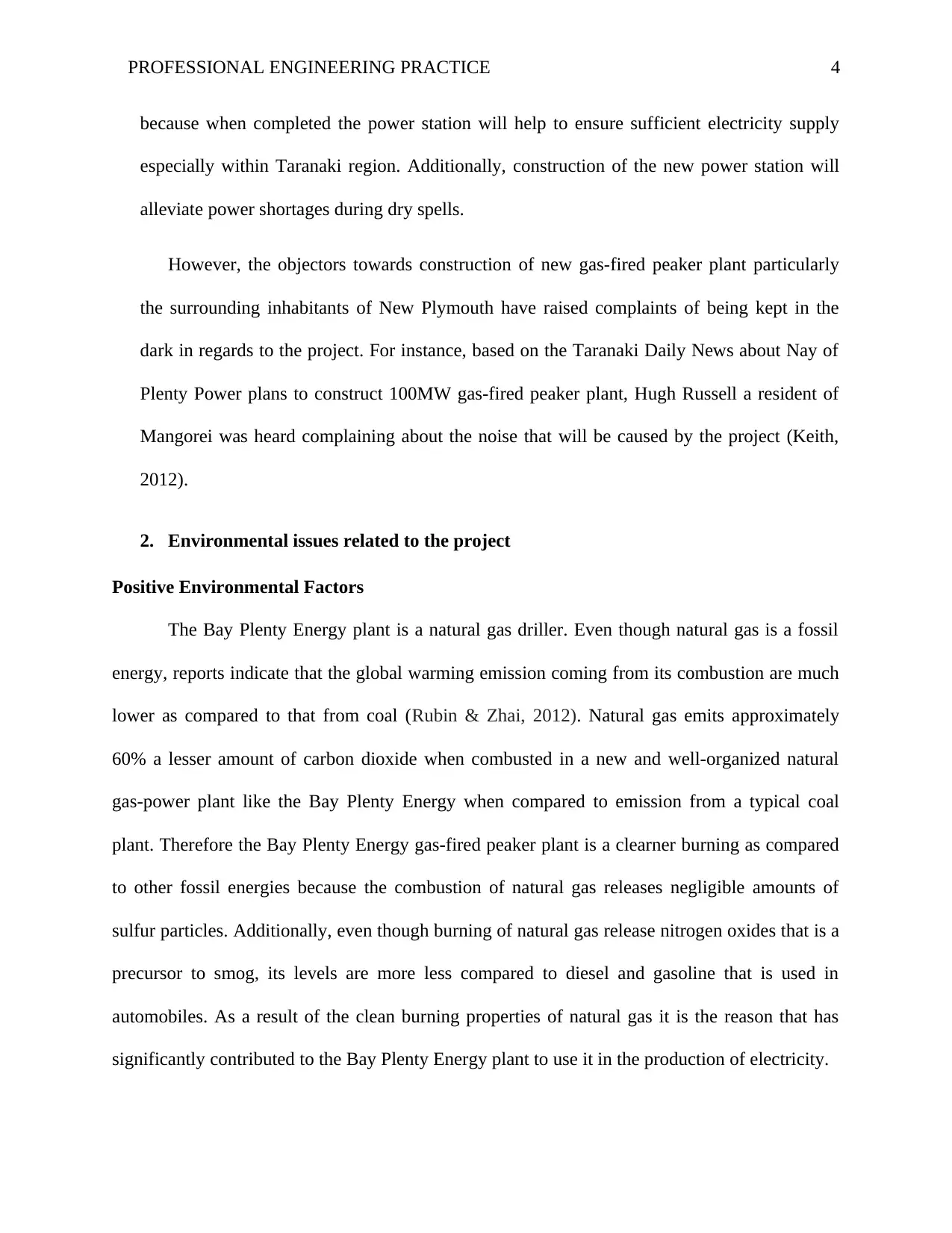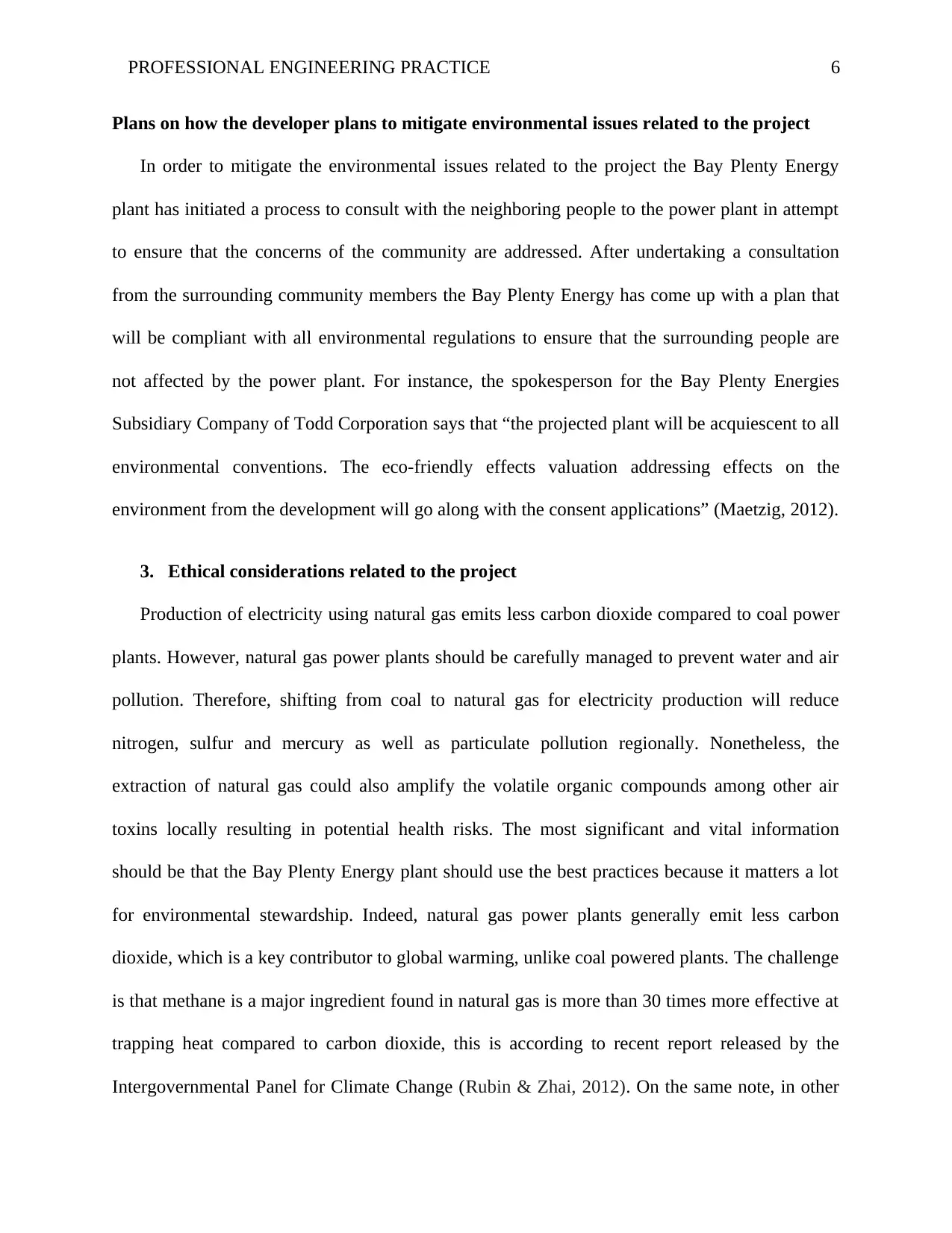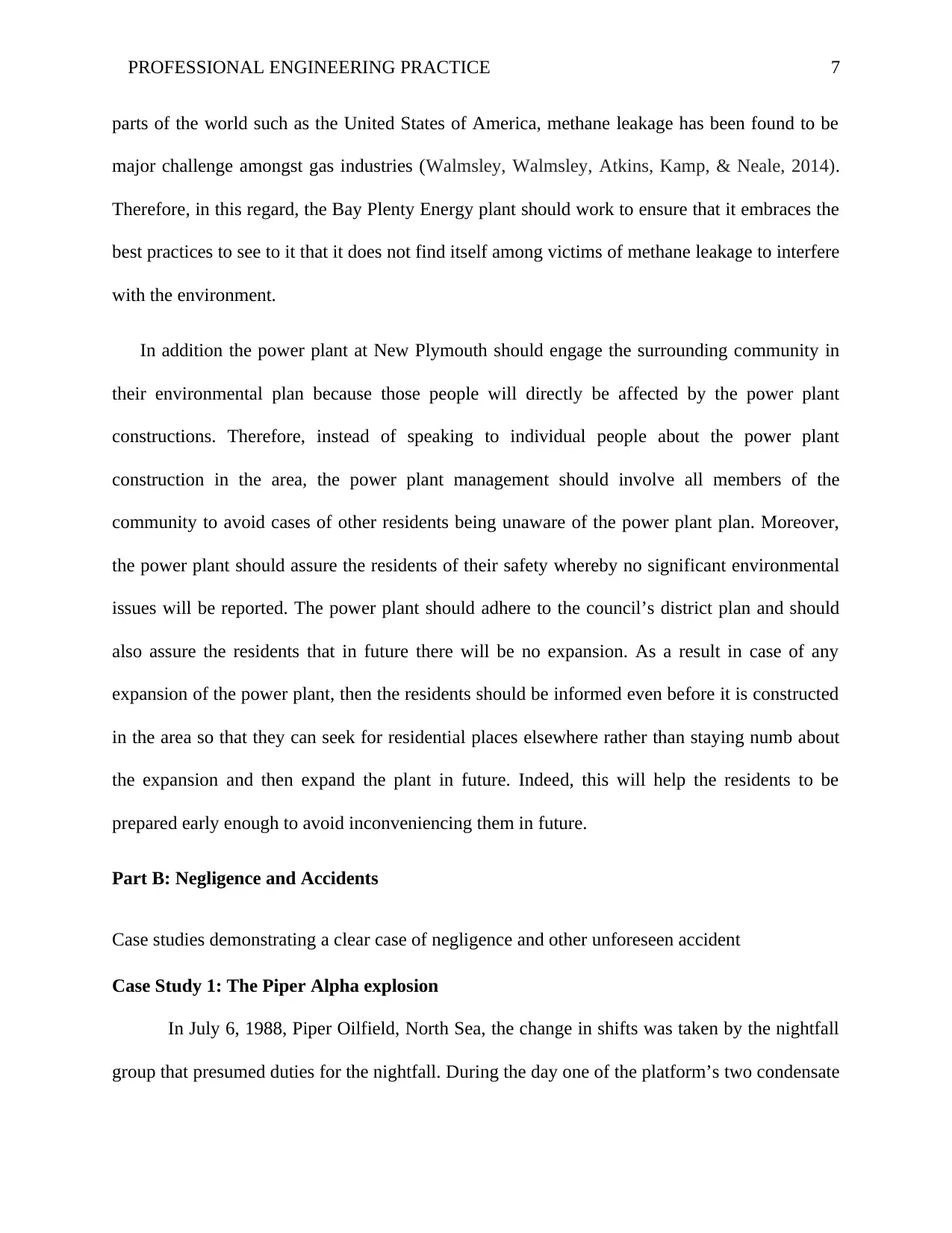Professional Engineering Practice Report: Gas Turbine Power Station
VerifiedAdded on 2022/12/05
|10
|2527
|265
Report
AI Summary
This report, prepared for ENGGMG7121, delves into the realm of professional engineering practice, focusing on a gas turbine power station project in Taranaki. It begins by outlining the various roles engineers play throughout the project's lifecycle, from the client and design consultant to the contractor, government, and objectors. The report then conducts a thorough environmental assessment, detailing both positive and negative impacts, addressing objectors' concerns, and outlining mitigation strategies. Ethical considerations are also explored, highlighting aspects engineers must consider to act responsibly. The report further examines negligence and accidents through case studies of the Piper Alpha explosion and the San Juanico disaster, analyzing the causes of these incidents and the associated failures in engineering practice. The assignment fulfills all the requirements of the assignment brief.

Running head: PROFESSIONAL ENGINEERING PRACTICE 1
Professional Engineering Practice
Student’s Name
Institutional Affiliation
Professional Engineering Practice
Student’s Name
Institutional Affiliation
Paraphrase This Document
Need a fresh take? Get an instant paraphrase of this document with our AI Paraphraser

PROFESSIONAL ENGINEERING PRACTICE 2
Table of Contents
Part A: The Role of the Engineer.................................................................................................................3
1. Summary of the project and list/describe the professional roles that engineers will have in the project
3
2. Environmental issues related to the project..........................................................................................4
Positive Environmental Factors...............................................................................................................4
Negative Environmental Factors.............................................................................................................5
Objectors’ issues against the project........................................................................................................5
Plans on how the developer plans to mitigate environmental issues related to the project.......................6
3. Ethical considerations related to the project........................................................................................6
Part B: Negligence and Accidents...........................................................................................................7
Case studies demonstrating a clear case of negligence and other unforeseen accident................................7
Case Study 1: The Piper Alpha explosion................................................................................................7
Explanation of the negligence that led to Piper Alpha explosion.............................................................8
Case Study 2: The San Juan Ixhautepec Liquefied Petroleum Gas explosion..........................................8
Table of Contents
Part A: The Role of the Engineer.................................................................................................................3
1. Summary of the project and list/describe the professional roles that engineers will have in the project
3
2. Environmental issues related to the project..........................................................................................4
Positive Environmental Factors...............................................................................................................4
Negative Environmental Factors.............................................................................................................5
Objectors’ issues against the project........................................................................................................5
Plans on how the developer plans to mitigate environmental issues related to the project.......................6
3. Ethical considerations related to the project........................................................................................6
Part B: Negligence and Accidents...........................................................................................................7
Case studies demonstrating a clear case of negligence and other unforeseen accident................................7
Case Study 1: The Piper Alpha explosion................................................................................................7
Explanation of the negligence that led to Piper Alpha explosion.............................................................8
Case Study 2: The San Juan Ixhautepec Liquefied Petroleum Gas explosion..........................................8

PROFESSIONAL ENGINEERING PRACTICE 3
Part A: The Role of the Engineer
1. Summary of the project and list/describe the professional roles that engineers will
have in the project
Bay of Plenty Energy is a branch of Todd Corporation which has won a proposal bid to
construct a 100 MW gas-fired peaker plant along Junction Road and Mangorei Road. Bay of
Plenty Energy deals with building of gas-fire peaker plants. Peaker plants are quick-start
power stations that are called into operation when electricity is on high demand and for
purposes of providing base load when there is deficit in wind and hydro power. The intend to
build the gas plant at this point is to be able to provide power to approximately 100,000
households once the plant becomes operational (Maetzig, 2012). Indeed, the new-fangled
power station in New Plymouth will increase the security of power supply for New Zealand
especially Taranaki region as well as improve the country’s power system elasticity against
dry spells.
Since the new power plant is to be built from scratch in the area the specialized role of
the engineers is to begin with Bay of Plenty Energy Company engaging its civil engineers.
The design engineers will have to prepare layouts as well as drawings of the construction
point and finalize it after it has been reviewed by the customer. The civil engineers have a
critical role to play towards construction of the power plant. Their work commence from the
very beginning with activities such as survey, site investigation, excavation, grading,
levelling, filling and foundation works.
The government through its administrators Taranaki Regional Council and New
Plymouth District Council are in support of Bay of Plenty Energy power plant construction
Part A: The Role of the Engineer
1. Summary of the project and list/describe the professional roles that engineers will
have in the project
Bay of Plenty Energy is a branch of Todd Corporation which has won a proposal bid to
construct a 100 MW gas-fired peaker plant along Junction Road and Mangorei Road. Bay of
Plenty Energy deals with building of gas-fire peaker plants. Peaker plants are quick-start
power stations that are called into operation when electricity is on high demand and for
purposes of providing base load when there is deficit in wind and hydro power. The intend to
build the gas plant at this point is to be able to provide power to approximately 100,000
households once the plant becomes operational (Maetzig, 2012). Indeed, the new-fangled
power station in New Plymouth will increase the security of power supply for New Zealand
especially Taranaki region as well as improve the country’s power system elasticity against
dry spells.
Since the new power plant is to be built from scratch in the area the specialized role of
the engineers is to begin with Bay of Plenty Energy Company engaging its civil engineers.
The design engineers will have to prepare layouts as well as drawings of the construction
point and finalize it after it has been reviewed by the customer. The civil engineers have a
critical role to play towards construction of the power plant. Their work commence from the
very beginning with activities such as survey, site investigation, excavation, grading,
levelling, filling and foundation works.
The government through its administrators Taranaki Regional Council and New
Plymouth District Council are in support of Bay of Plenty Energy power plant construction
⊘ This is a preview!⊘
Do you want full access?
Subscribe today to unlock all pages.

Trusted by 1+ million students worldwide

PROFESSIONAL ENGINEERING PRACTICE 4
because when completed the power station will help to ensure sufficient electricity supply
especially within Taranaki region. Additionally, construction of the new power station will
alleviate power shortages during dry spells.
However, the objectors towards construction of new gas-fired peaker plant particularly
the surrounding inhabitants of New Plymouth have raised complaints of being kept in the
dark in regards to the project. For instance, based on the Taranaki Daily News about Nay of
Plenty Power plans to construct 100MW gas-fired peaker plant, Hugh Russell a resident of
Mangorei was heard complaining about the noise that will be caused by the project (Keith,
2012).
2. Environmental issues related to the project
Positive Environmental Factors
The Bay Plenty Energy plant is a natural gas driller. Even though natural gas is a fossil
energy, reports indicate that the global warming emission coming from its combustion are much
lower as compared to that from coal (Rubin & Zhai, 2012). Natural gas emits approximately
60% a lesser amount of carbon dioxide when combusted in a new and well-organized natural
gas-power plant like the Bay Plenty Energy when compared to emission from a typical coal
plant. Therefore the Bay Plenty Energy gas-fired peaker plant is a clearner burning as compared
to other fossil energies because the combustion of natural gas releases negligible amounts of
sulfur particles. Additionally, even though burning of natural gas release nitrogen oxides that is a
precursor to smog, its levels are more less compared to diesel and gasoline that is used in
automobiles. As a result of the clean burning properties of natural gas it is the reason that has
significantly contributed to the Bay Plenty Energy plant to use it in the production of electricity.
because when completed the power station will help to ensure sufficient electricity supply
especially within Taranaki region. Additionally, construction of the new power station will
alleviate power shortages during dry spells.
However, the objectors towards construction of new gas-fired peaker plant particularly
the surrounding inhabitants of New Plymouth have raised complaints of being kept in the
dark in regards to the project. For instance, based on the Taranaki Daily News about Nay of
Plenty Power plans to construct 100MW gas-fired peaker plant, Hugh Russell a resident of
Mangorei was heard complaining about the noise that will be caused by the project (Keith,
2012).
2. Environmental issues related to the project
Positive Environmental Factors
The Bay Plenty Energy plant is a natural gas driller. Even though natural gas is a fossil
energy, reports indicate that the global warming emission coming from its combustion are much
lower as compared to that from coal (Rubin & Zhai, 2012). Natural gas emits approximately
60% a lesser amount of carbon dioxide when combusted in a new and well-organized natural
gas-power plant like the Bay Plenty Energy when compared to emission from a typical coal
plant. Therefore the Bay Plenty Energy gas-fired peaker plant is a clearner burning as compared
to other fossil energies because the combustion of natural gas releases negligible amounts of
sulfur particles. Additionally, even though burning of natural gas release nitrogen oxides that is a
precursor to smog, its levels are more less compared to diesel and gasoline that is used in
automobiles. As a result of the clean burning properties of natural gas it is the reason that has
significantly contributed to the Bay Plenty Energy plant to use it in the production of electricity.
Paraphrase This Document
Need a fresh take? Get an instant paraphrase of this document with our AI Paraphraser

PROFESSIONAL ENGINEERING PRACTICE 5
Negative Environmental Factors
Progressive gas development has effects to both local as well as regional quality of air.
Recent studies has shown that in places where drilling has occurred they have experienced
increased concentrations of hazardous air pollutants. However, exposure to raised air pollutant
levels could lead to adverse health complications such as cancer, cardiovascular disease and
respiratory symptoms. On the same note, the construction and land disturbance needed for gas
drilling is likely to interfere with land usage and even harm the local ecosystem by causing
erosion. During Bay Plenty Energy plant construction the engineers will have to clear the site to
construct a well pad, access roads and pipelines which will cause erosion of minerals, dirt and
harmful pollutants to the nearby waterbody.
Objectors’ issues against the project
Those opposing the construction of the Bay Plenty Energy gas-fired peaker plant of New
Plymouth is because they have not been informed about the construction. For example, Hugh
Russell a resident of Mangorei Rd states that “he is not aware a power station is going to be built
in the area at the time he was purchasing his home some year back. Therefore, he is concerned
about the noise and the visual effects associated with the power plant” (Maetzig, 2012). Hence
Russell object the construction of the plant. In addition to that, the power plant is objected
because it is believed Rodd Company is cunning because it talks to the effected inhabitants
individually instead of talking to them as a group. It is also believed that the plant could be
expanded in future as there is no guarantee that it may not since once the plant is built they likely
to fix the expansion. Furthermore, building of the plant in the area could come with concerns
such as noise, air and light pollution and also lead to hike in property prices in the region.
Negative Environmental Factors
Progressive gas development has effects to both local as well as regional quality of air.
Recent studies has shown that in places where drilling has occurred they have experienced
increased concentrations of hazardous air pollutants. However, exposure to raised air pollutant
levels could lead to adverse health complications such as cancer, cardiovascular disease and
respiratory symptoms. On the same note, the construction and land disturbance needed for gas
drilling is likely to interfere with land usage and even harm the local ecosystem by causing
erosion. During Bay Plenty Energy plant construction the engineers will have to clear the site to
construct a well pad, access roads and pipelines which will cause erosion of minerals, dirt and
harmful pollutants to the nearby waterbody.
Objectors’ issues against the project
Those opposing the construction of the Bay Plenty Energy gas-fired peaker plant of New
Plymouth is because they have not been informed about the construction. For example, Hugh
Russell a resident of Mangorei Rd states that “he is not aware a power station is going to be built
in the area at the time he was purchasing his home some year back. Therefore, he is concerned
about the noise and the visual effects associated with the power plant” (Maetzig, 2012). Hence
Russell object the construction of the plant. In addition to that, the power plant is objected
because it is believed Rodd Company is cunning because it talks to the effected inhabitants
individually instead of talking to them as a group. It is also believed that the plant could be
expanded in future as there is no guarantee that it may not since once the plant is built they likely
to fix the expansion. Furthermore, building of the plant in the area could come with concerns
such as noise, air and light pollution and also lead to hike in property prices in the region.

PROFESSIONAL ENGINEERING PRACTICE 6
Plans on how the developer plans to mitigate environmental issues related to the project
In order to mitigate the environmental issues related to the project the Bay Plenty Energy
plant has initiated a process to consult with the neighboring people to the power plant in attempt
to ensure that the concerns of the community are addressed. After undertaking a consultation
from the surrounding community members the Bay Plenty Energy has come up with a plan that
will be compliant with all environmental regulations to ensure that the surrounding people are
not affected by the power plant. For instance, the spokesperson for the Bay Plenty Energies
Subsidiary Company of Todd Corporation says that “the projected plant will be acquiescent to all
environmental conventions. The eco-friendly effects valuation addressing effects on the
environment from the development will go along with the consent applications” (Maetzig, 2012).
3. Ethical considerations related to the project
Production of electricity using natural gas emits less carbon dioxide compared to coal power
plants. However, natural gas power plants should be carefully managed to prevent water and air
pollution. Therefore, shifting from coal to natural gas for electricity production will reduce
nitrogen, sulfur and mercury as well as particulate pollution regionally. Nonetheless, the
extraction of natural gas could also amplify the volatile organic compounds among other air
toxins locally resulting in potential health risks. The most significant and vital information
should be that the Bay Plenty Energy plant should use the best practices because it matters a lot
for environmental stewardship. Indeed, natural gas power plants generally emit less carbon
dioxide, which is a key contributor to global warming, unlike coal powered plants. The challenge
is that methane is a major ingredient found in natural gas is more than 30 times more effective at
trapping heat compared to carbon dioxide, this is according to recent report released by the
Intergovernmental Panel for Climate Change (Rubin & Zhai, 2012). On the same note, in other
Plans on how the developer plans to mitigate environmental issues related to the project
In order to mitigate the environmental issues related to the project the Bay Plenty Energy
plant has initiated a process to consult with the neighboring people to the power plant in attempt
to ensure that the concerns of the community are addressed. After undertaking a consultation
from the surrounding community members the Bay Plenty Energy has come up with a plan that
will be compliant with all environmental regulations to ensure that the surrounding people are
not affected by the power plant. For instance, the spokesperson for the Bay Plenty Energies
Subsidiary Company of Todd Corporation says that “the projected plant will be acquiescent to all
environmental conventions. The eco-friendly effects valuation addressing effects on the
environment from the development will go along with the consent applications” (Maetzig, 2012).
3. Ethical considerations related to the project
Production of electricity using natural gas emits less carbon dioxide compared to coal power
plants. However, natural gas power plants should be carefully managed to prevent water and air
pollution. Therefore, shifting from coal to natural gas for electricity production will reduce
nitrogen, sulfur and mercury as well as particulate pollution regionally. Nonetheless, the
extraction of natural gas could also amplify the volatile organic compounds among other air
toxins locally resulting in potential health risks. The most significant and vital information
should be that the Bay Plenty Energy plant should use the best practices because it matters a lot
for environmental stewardship. Indeed, natural gas power plants generally emit less carbon
dioxide, which is a key contributor to global warming, unlike coal powered plants. The challenge
is that methane is a major ingredient found in natural gas is more than 30 times more effective at
trapping heat compared to carbon dioxide, this is according to recent report released by the
Intergovernmental Panel for Climate Change (Rubin & Zhai, 2012). On the same note, in other
⊘ This is a preview!⊘
Do you want full access?
Subscribe today to unlock all pages.

Trusted by 1+ million students worldwide

PROFESSIONAL ENGINEERING PRACTICE 7
parts of the world such as the United States of America, methane leakage has been found to be
major challenge amongst gas industries (Walmsley, Walmsley, Atkins, Kamp, & Neale, 2014).
Therefore, in this regard, the Bay Plenty Energy plant should work to ensure that it embraces the
best practices to see to it that it does not find itself among victims of methane leakage to interfere
with the environment.
In addition the power plant at New Plymouth should engage the surrounding community in
their environmental plan because those people will directly be affected by the power plant
constructions. Therefore, instead of speaking to individual people about the power plant
construction in the area, the power plant management should involve all members of the
community to avoid cases of other residents being unaware of the power plant plan. Moreover,
the power plant should assure the residents of their safety whereby no significant environmental
issues will be reported. The power plant should adhere to the council’s district plan and should
also assure the residents that in future there will be no expansion. As a result in case of any
expansion of the power plant, then the residents should be informed even before it is constructed
in the area so that they can seek for residential places elsewhere rather than staying numb about
the expansion and then expand the plant in future. Indeed, this will help the residents to be
prepared early enough to avoid inconveniencing them in future.
Part B: Negligence and Accidents
Case studies demonstrating a clear case of negligence and other unforeseen accident
Case Study 1: The Piper Alpha explosion
In July 6, 1988, Piper Oilfield, North Sea, the change in shifts was taken by the nightfall
group that presumed duties for the nightfall. During the day one of the platform’s two condensate
parts of the world such as the United States of America, methane leakage has been found to be
major challenge amongst gas industries (Walmsley, Walmsley, Atkins, Kamp, & Neale, 2014).
Therefore, in this regard, the Bay Plenty Energy plant should work to ensure that it embraces the
best practices to see to it that it does not find itself among victims of methane leakage to interfere
with the environment.
In addition the power plant at New Plymouth should engage the surrounding community in
their environmental plan because those people will directly be affected by the power plant
constructions. Therefore, instead of speaking to individual people about the power plant
construction in the area, the power plant management should involve all members of the
community to avoid cases of other residents being unaware of the power plant plan. Moreover,
the power plant should assure the residents of their safety whereby no significant environmental
issues will be reported. The power plant should adhere to the council’s district plan and should
also assure the residents that in future there will be no expansion. As a result in case of any
expansion of the power plant, then the residents should be informed even before it is constructed
in the area so that they can seek for residential places elsewhere rather than staying numb about
the expansion and then expand the plant in future. Indeed, this will help the residents to be
prepared early enough to avoid inconveniencing them in future.
Part B: Negligence and Accidents
Case studies demonstrating a clear case of negligence and other unforeseen accident
Case Study 1: The Piper Alpha explosion
In July 6, 1988, Piper Oilfield, North Sea, the change in shifts was taken by the nightfall
group that presumed duties for the nightfall. During the day one of the platform’s two condensate
Paraphrase This Document
Need a fresh take? Get an instant paraphrase of this document with our AI Paraphraser

PROFESSIONAL ENGINEERING PRACTICE 8
pumps experienced failure. Therefore, the day shift crew operated to resolve the matter before
effecting the platform production. Nonetheless, unfamiliar to the evening group, the failure
happened a few hours after a key pressure safety valve had been detached from the other
condensate pump system and was provisionally substituted by a hand-tightened blind extension
(Swuste, Groeneweg, Van Gulijk, Zwaard, & Lemkowitz, 2018). Thus, when the evening shift
turned on the other condensate pump system, the blind extension failed due to the high pressure.
Hence it led to a series of reaction of outbursts and failure across Piper Alpha killing 167
employees.
Explanation of the negligence that led to Piper Alpha explosion
Despite the fact that Piper Alpha was prepared with automatic firefighting kit, a
technique developed by the administration platform had neutralized the mechanization of the
system when divers were operating in the water to prevent them from being gulped through
programmed water pump caged intakes. It became a custom that divers could work for more than
10 hours in a day during summer period in the North Sea, nonetheless they never saw any risk
not unless they were operating over 10 feet from the ingestions. While it was recommended that
pumps should remain in automatic state if divers were not operating nearby to the intakes, this
commendation was never applied. To prevent Piper Alpha explosion from happening, the day
and night shift could have enhanced communication between the two shifts. With
communication between the two shifts it could have been possible for the night shift to get
information regarding the hand-tightened blind flange used (Swuste et al., 2018).
Case Study 2: The San Juan Ixhautepec Liquefied Petroleum Gas explosion
San Juanico disaster happened as a result of gas leak on the site, which was caused by a
pipe rapture at the time of transfer operations, which caused a plume of LPG to get concentrated
pumps experienced failure. Therefore, the day shift crew operated to resolve the matter before
effecting the platform production. Nonetheless, unfamiliar to the evening group, the failure
happened a few hours after a key pressure safety valve had been detached from the other
condensate pump system and was provisionally substituted by a hand-tightened blind extension
(Swuste, Groeneweg, Van Gulijk, Zwaard, & Lemkowitz, 2018). Thus, when the evening shift
turned on the other condensate pump system, the blind extension failed due to the high pressure.
Hence it led to a series of reaction of outbursts and failure across Piper Alpha killing 167
employees.
Explanation of the negligence that led to Piper Alpha explosion
Despite the fact that Piper Alpha was prepared with automatic firefighting kit, a
technique developed by the administration platform had neutralized the mechanization of the
system when divers were operating in the water to prevent them from being gulped through
programmed water pump caged intakes. It became a custom that divers could work for more than
10 hours in a day during summer period in the North Sea, nonetheless they never saw any risk
not unless they were operating over 10 feet from the ingestions. While it was recommended that
pumps should remain in automatic state if divers were not operating nearby to the intakes, this
commendation was never applied. To prevent Piper Alpha explosion from happening, the day
and night shift could have enhanced communication between the two shifts. With
communication between the two shifts it could have been possible for the night shift to get
information regarding the hand-tightened blind flange used (Swuste et al., 2018).
Case Study 2: The San Juan Ixhautepec Liquefied Petroleum Gas explosion
San Juanico disaster happened as a result of gas leak on the site, which was caused by a
pipe rapture at the time of transfer operations, which caused a plume of LPG to get concentrated

PROFESSIONAL ENGINEERING PRACTICE 9
at ground level for over ten minutes. Eventually, the plume intensified to unbearable that led to
drift on the wind in the west direction of site a place where the waste-gas flare for the facility
was located (Murthy & Serikova, 2016). The disaster happened as a result of failure in technical
measures since there was no safety layout inclusion in the plant as well as emergency isolation
features. The San Juanico disaster could have been prevented if the plant could have installed
effective gas detectors and emergency isolation systems.
at ground level for over ten minutes. Eventually, the plume intensified to unbearable that led to
drift on the wind in the west direction of site a place where the waste-gas flare for the facility
was located (Murthy & Serikova, 2016). The disaster happened as a result of failure in technical
measures since there was no safety layout inclusion in the plant as well as emergency isolation
features. The San Juanico disaster could have been prevented if the plant could have installed
effective gas detectors and emergency isolation systems.
⊘ This is a preview!⊘
Do you want full access?
Subscribe today to unlock all pages.

Trusted by 1+ million students worldwide

PROFESSIONAL ENGINEERING PRACTICE 10
References
Keith, L. (2012). Residents fear power plant expansion. Retrieved 8 September 2019, from
http://www.stuff.co.nz/taranaki-daily-news/news/7271588/Residents-fear-power-plant-
expansion?rm=m
Maetzig, R. (2012). New Plymouth to get power station. Retrieved 9 September 2019, from
http://www.stuff.co.nz/taranaki-daily-news/news/7264373/New-Plymouth-to-get-power-
station?rm=m
Murthy, M., & Serikova, N. (2016). Selection of failure frequency and its impact on risk
assessment–A case study from plot plan optimisation. Journal of Loss Prevention in the
Process Industries, 44, 690-698.
Rubin, E. S., & Zhai, H. (2012). The cost of carbon capture and storage for natural gas combined
cycle power plants. Environmental science & technology, 46(6), 3076-3084.
https://pubs.acs.org/doi/abs/10.1021/es204514f
Swuste, P., Groeneweg, J., Van Gulijk, C., Zwaard, W., & Lemkowitz, S. (2018). Safety
management systems from Three Mile Island to Piper Alpha, a review in English and
Dutch literature for the period 1979 to 1988. Safety science, 107, 224-244.
Walmsley, M. R., Walmsley, T. G., Atkins, M. J., Kamp, P. J., & Neale, J. R. (2014).
Minimising carbon emissions and energy expended for electricity generation in New
Zealand through to 2050. Applied energy, 135, 656-665.
References
Keith, L. (2012). Residents fear power plant expansion. Retrieved 8 September 2019, from
http://www.stuff.co.nz/taranaki-daily-news/news/7271588/Residents-fear-power-plant-
expansion?rm=m
Maetzig, R. (2012). New Plymouth to get power station. Retrieved 9 September 2019, from
http://www.stuff.co.nz/taranaki-daily-news/news/7264373/New-Plymouth-to-get-power-
station?rm=m
Murthy, M., & Serikova, N. (2016). Selection of failure frequency and its impact on risk
assessment–A case study from plot plan optimisation. Journal of Loss Prevention in the
Process Industries, 44, 690-698.
Rubin, E. S., & Zhai, H. (2012). The cost of carbon capture and storage for natural gas combined
cycle power plants. Environmental science & technology, 46(6), 3076-3084.
https://pubs.acs.org/doi/abs/10.1021/es204514f
Swuste, P., Groeneweg, J., Van Gulijk, C., Zwaard, W., & Lemkowitz, S. (2018). Safety
management systems from Three Mile Island to Piper Alpha, a review in English and
Dutch literature for the period 1979 to 1988. Safety science, 107, 224-244.
Walmsley, M. R., Walmsley, T. G., Atkins, M. J., Kamp, P. J., & Neale, J. R. (2014).
Minimising carbon emissions and energy expended for electricity generation in New
Zealand through to 2050. Applied energy, 135, 656-665.
1 out of 10
Your All-in-One AI-Powered Toolkit for Academic Success.
+13062052269
info@desklib.com
Available 24*7 on WhatsApp / Email
![[object Object]](/_next/static/media/star-bottom.7253800d.svg)
Unlock your academic potential
Copyright © 2020–2025 A2Z Services. All Rights Reserved. Developed and managed by ZUCOL.


